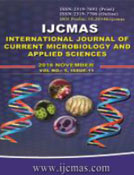


 National Academy of Agricultural Sciences (NAAS)
National Academy of Agricultural Sciences (NAAS)

|
PRINT ISSN : 2319-7692
Online ISSN : 2319-7706 Issues : 12 per year Publisher : Excellent Publishers Email : editorijcmas@gmail.com / submit@ijcmas.com Editor-in-chief: Dr.M.Prakash Index Copernicus ICV 2018: 95.39 NAAS RATING 2020: 5.38 |
Formal-ether concentration technique is considered to be the gold standard method to diagnose intestinal parasitic infection. This technique requires ether as a fat solvent to clear the debris which results in high positivity rate. Since ether is an explosive and contains anaesthetic vapour, it is associated with serious health hazards. Consequently, other fat solvents such as, ethyl acetate, tween, acetone and petrol have been proposed as alternatives. This study was done to evaluate the use of acetone as a substitute for ether by comparing formal- acetone with formal-ether concentration and other techniques, such as, saturated salt flotation and direct microscopy in order to know its effectiveness in diagnosing intestinal parasitosis. A total of 309 consecutive stool samples received during November 2013 to January 2014 were included in the study. All stool samples were processed by formal-acetone concentration method and compared with direct wet mount, salt flotation method and formalin-ether concentration method and the results were compared and analysed. With 309 stool samples, the prevalence of intestinal parasitic infestation was 11%,13%, 10% and 6% with formal-ether concentration, formal-acetone concentration, salt-flotation and wet-mount preparations respectively. Though Formalin-ether concentration method isthe gold- standard technique for detection of intestinal parasites in stool, it may cause considerable health hazards. Formal- acetone can be adopted as an equally effective stool examination technique with minimal side effects and satisfactory diagnostic yield.
 |
 |
 |
 |
 |